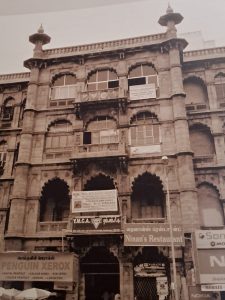
The Academy was inaugurated at the YMCA Building on Esplanade
A red-letter day for the Music Academy, Madras. The history of this landmark institution goes back to the mid-twenties. At that time, several well wishers and lovers of music felt that steps should be taken to stimulate interest in Carnatic music in the South and to develop a musical culture along sound lines, by establishing an academy in Madras city. The idea took a definite shape when the All-India Music Conference (held in Madras from 24th to 31st December 1927) passed on 22nd January 1928, a resolution recommending among other things, “that an Academy of Music be started at Madras” for the purpose of fostering Indian music and to encourage the study of the theory and practice of music.
A constitution and necessary rules and regulations for the Academy were framed by a committee appointed for the purpose, and adopted. A provisional executive committee was also appointed on 5th March 1928 to organise the Academy and start its work. Heading it was Dr U. Rama Rau in the capacity of President.

In April 1928 an Experts’ Committee consisting of some of the leading musicians and scholars was also elected to advise the Academy on all technical matters including music education on correct and modern lines. The members of the Committee (which from then on came to be known as the Executive Committee) were doyens like Bidaram Krishnappa, Ariyakkudi Ramanuja Iyengar, Palladam Sanjeeva Rao, Pudukottai Dakshinamurthi Pillai, Prof. Dwaram Venkataswami Naidu, Jalatarangam Ramaniah Chetty, Zamindar of Seithur, M.S. Ramaswami Iyer, W. Doraiswami Iyengar, Rao Bahadur C. Ramanujachariar, T.L. Venkatarama Iyer, T.V. Subba Rao and P. Sambamurthy, a galaxy indeed.
In the opening pages of the book titled ‘Four Score & More, The History of the Music Academy, Madras’, its authors Sriram V & Malathi Rangaswami give us interesting insights into the Academy’s genesis, the inauguration and its first steps in those times. To quote:
“An appeal dated 16th August 1928, signed by the members of the Executive Committee, was drafted and circulated, wherein the different classifications of members was spelt out. The Patrons were to pay Rs. 500 each and a Life Member Rs. 100. An Ordinary Member was to pay an entrance fee of Rs. 5 every year and a monthly subscription of Re. 1. If paid in advance for a half-year, he was entitled to a discount of Re. 1 in the total fee payable.”
The Office of the Academy was located at 323, Thambu Chetty Street, where Dr U. Rama Rao, the founder President had his dispensary. The enrolment of members began.
“On 15th August 1928, The Hindu carried the announcement that the ‘Music Academy, Madras will be opened on Saturday, 18th instant at 4.15 pm at the YMCA Auditorium, Esplanade, Madras, by Sir C.P. Ramaswami Iyer’. The venue, a handsome, red, sandstone structure still stands.”
The Academy was formally inaugurated at a public function on 18th August 1928. The opening ceremony was performed by Sir C.P. Ramaswami Iyer at the YMCA Auditorium, Esplanade, before a large and distinguished gathering. “It witnessed a speech by Sir CP, and yet another by M.S. Ramaswami Iyer. This was followed by a vocal concert by Kanchipuram Naina Pillai accompanied by Madras Balakrishna Iyer on the violin and Ayilur Akhileswara Iyer on the mridangam. In keeping with the Academy’s resolution, the number of accompanists had been restricted to two and Naina must have needed some persuasion to give up his usual “full bench” of nine and more accompanists! The time duration too was two hours and not what Naina, the champion of mammoth performances was accustomed to.”
“Perhaps in keeping with the aims and objectives of the Academy, which intended to do more for music than merely hold concerts, both the city’s leading newspapers, The Hindu and The Mail, devoted at least three columns to the speeches of Sir CP and M.S. Ramaswami Iyer and dismissed the concert in a few lines.”
“The inauguration concluded, the Committee set to work out a series of programmes for the first year. The plan was to have a mix of presentations and papers which would represent the academic side and also hold concerts regularly, which being ticketed performances would bring in the much needed money.”
“The Music Academy held the first of what it termed as ‘a series of instructive lectures and demonstrations’ on 8th September 1928 at the Pacchaiyappa’s Hall, a short distance away from where the inauguration had taken place.”
Since its inception, the Academy has been ceaselessly endeavouring for the advancement of the science and art of Indian music.
The objects of the Academy, inter-alia are: to hold annual music conferences during December or at any other convenient period; to investigate, collect, preserve and publish compositions, manuscripts and books relating to music and dance; to establish and maintain a library and a museum to publish a journal; to encourage and help deserving musicians, dancers and scholars by bringing them to the notice of the public; to help and conduct examinations, tests and competitions; and to make representations from time to time to the authorities in all matters relating to music. In short, it is the endeavour of this institution to give to music its rightful place in our national life.
S. JANAKI